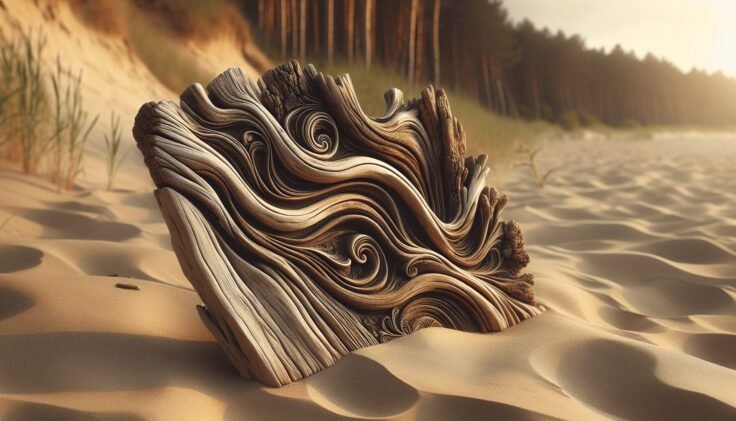Have you ever considered how something as simple as driftwood could transform your garden or outdoor space into an inviting and unique retreat? Driftwood edging is a versatile, eco-friendly option that can add character and warmth to your landscape. Whether you’re aiming for a rustic look or a more refined feel, driftwood can be adapted to suit your style. Let’s explore the many facets of driftwood edging and how it can enhance your surroundings.

What is Driftwood?
Driftwood is wood that has been washed ashore by the action of winds, tides, or waves. Over time, the wood is bleached by the sun and smoothed by the water, giving it a unique and appealing appearance. It is often light, soft, and textured, which makes it ideal for creative projects like garden edging.
Characteristics of Driftwood
Driftwood is celebrated for its natural beauty and unique characteristics. No two pieces are the same, making each one a distinctive addition to your outdoor space. Driftwood pieces often display soft, muted colors and smooth, weathered surfaces. The natural curves and lines contribute to a rustic aesthetic that compliments many garden designs.
Ecological Benefits
Using driftwood is an eco-friendly choice. By repurposing wood that would otherwise be left to decay, you are not only recycling but also reducing the need for manufactured materials. Driftwood collection ensures you’re making a sustainable choice, benefiting both your garden and the environment.
Why Choose Driftwood Edging?
Driftwood edging offers numerous benefits that make it an attractive option for garden enthusiasts. It’s not just about aesthetics; the practical advantages also make it an excellent choice for many different types of landscapes.
Aesthetic Advantages
The unique appearance of driftwood can transform a mundane garden into a stunning escape. Its organic shapes and natural colors can seamlessly blend into a variety of garden styles, from coastal and rustic to modern and minimalist. Driftwood creates visual interest and lends a touch of authenticity and warmth that is hard to replicate with other materials.
Practical Benefits
Beyond its aesthetic appeal, driftwood edging is incredibly durable and can withstand various weather conditions. The dense wood is naturally resistant to moisture, pests, and decay, ensuring your garden edges remain beautiful for many years. Moreover, driftwood pieces are easy to work with, often requiring minimal tools and effort to install.
How to Collect Driftwood
Before beginning your driftwood edging project, it’s essential to know how to collect driftwood responsibly. Overharvesting can disrupt local ecosystems, so ethical collection practices are crucial.
Finding Driftwood
Beaches and riverbanks are common places to find driftwood. It’s best to look after storms, as drifting pieces may be washed ashore in larger quantities. Remember to check local regulations, as some areas have specific rules regarding the collection of natural materials to protect wildlife habitats.
Ensuring Quality
When selecting driftwood for edging, look for pieces that are solid and free of rot. Choose varying sizes and shapes to create a more organic and varied design. Avoid collecting pieces with sharp edges or those that are too fragile, as they may not withstand the elements over time.
Preparing Driftwood for Use
Once you’ve collected your driftwood, some preparation is necessary to ensure it is ready for use in your garden. This step is crucial to maintaining the wood’s integrity and enhancing its longevity.
Cleaning and Sanitizing
First, rinse the driftwood thoroughly to remove salt, sand, or debris. A light scrubbing with a brush and mild detergent can help clean stubborn spots. Once clean, soaking the wood in a water and bleach solution can remove bacteria and pests. Afterward, allow it to dry completely in the sun, as this also helps in lightening the wood.
Selecting the Right Pieces
Consider the garden edge’s location and the purpose of the driftwood when choosing pieces. For more structured borders, longer, straighter pieces are ideal. If you’re aiming for a natural, flowing design, select pieces with more curves and textures.

Designing with Driftwood Edging
Creating a cohesive design using driftwood can enhance the overall appearance of your garden or outdoor space. Thoughtful design and planning are key to achieving a well-balanced look.
Planning Your Design
Sketch a rough layout of your garden and decide where driftwood edging would be most effective. Consider aspects like visibility, function, and the layout of existing plants or structures. Decide if you want your driftwood edging to be a primary feature or a subtle complement to other elements.
Creative Ideas
Natural Borders: Use driftwood to outline garden beds or pathways, allowing the natural shapes to guide the flow of your design.
Tiered Layers: Stack driftwood pieces to create tiered layers, adding depth and dimension to your garden.
Rock and Wood Combination: Pair driftwood with stones or boulders to enhance texture and create a dynamic contrast in your garden.
Installation Tips
Installing driftwood edging requires some forethought to ensure it is both secure and aesthetically pleasing. With the right tools and methods, you’ll be able to create a versatile and lasting design feature.
Tools You Might Need
- Shovel or spade
- Hammer or mallet
- Garden stakes or rebar
- Safety gloves
Step-by-Step Installation
Outline the Perimeter: Use stakes and string to outline the area where the driftwood will be placed.
Dig a Trench: Create a shallow trench along the outlined area to help position the driftwood securely.
Place the Driftwood: Arrange the driftwood pieces in the trench, ensuring they are tightly secured and in contact with one another. For added stability, consider driving stakes or rebar behind larger pieces.
Fill and Compact: Backfill the trench with soil or sand and compact it around the base of the driftwood to hold it firmly in place.
Maintenance Tips
To keep your driftwood edging looking its best, regular maintenance is essential. Although driftwood is durable, it benefits from occasional care.
Basic Care
Regularly inspect your driftwood edging for signs of rot, pests, or shifting. Clean the wood annually to remove dirt and debris, and reposition any pieces that may have become loose.
Weather Protection
To protect your driftwood from excessive moisture or intense sunlight, consider applying a clear outdoor wood sealant. This can help maintain the integrity and appearance of the driftwood over time.
Potential Challenges
While driftwood edging offers numerous advantages, there are potential challenges you may face. Being aware of these can help you address them promptly and prevent larger issues down the road.
Sourcing Quality Driftwood
Finding suitable pieces can be time-consuming, especially if you lack access to locations where driftwood is abundant. Consider reaching out to local suppliers or artisans who might sell pre-collected driftwood.
Ensuring Longevity
To enhance the driftwood’s durability, ensure it is thoroughly treated and cured before installation. This will help prevent decay and extend the life of your edging.
Driftwood Edging Projects for Inspiration
Need some creative inspiration? Here are a few ideas to inspire your next driftwood edging project. Each one demonstrates how this natural material can be used in unique and innovative ways.
Coastal Garden Pathway
Create a beautiful coastal-themed pathway by aligning driftwood pieces to outline the path. Use curves and varying heights to mimic the natural flow of water, and incorporate shells and small rocks for added texture.
Raised Bed Borders
Use sturdy, substantial pieces of driftwood to construct raised bed borders. This design not only helps define your garden space but also adds an artistic element through the wood’s natural forms.
Decorative Features
Integrate driftwood into your existing garden features by adding it to fences, benches, or water features. The combination of materials will enrich the texture and visual interest of your outdoor space.
Conclusion
Driftwood edging is an innovative and sustainable way to beautify your garden or outdoor area. Its natural beauty, durability, and versatility make it an ideal choice for many landscapes. Whether you’re installing it yourself or seeking inspiration for a professional project, driftwood can enhance your environment while keeping its impact on the planet light. By choosing this beautiful material, you’re not just designing a garden—you’re crafting a unique outdoor experience. So, step into the world of driftwood and let its natural elegance frame your garden in ways only nature can inspire.